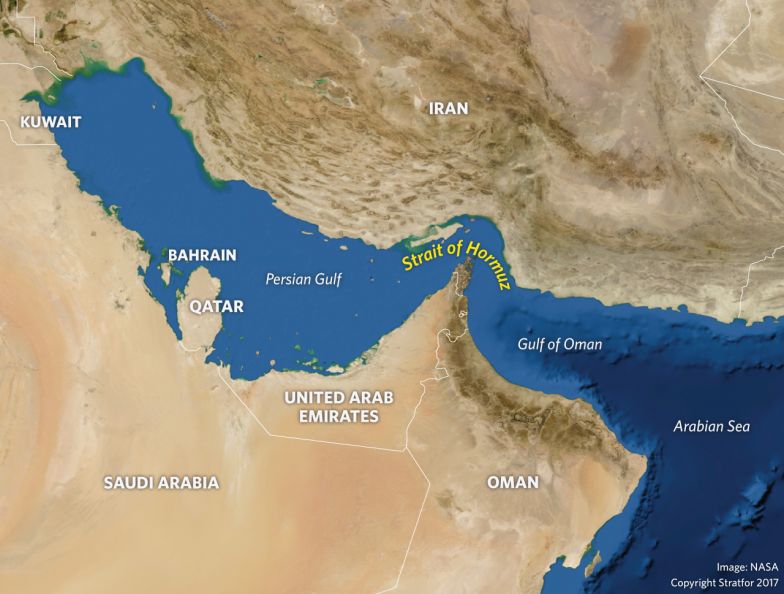Why the Strait of Hormuz matters
One fifth of the world’s crude and oil liquids are transported through the strait, making it the world’s most important oil artery
Photo: Stratfor

Saudi Arabia said on Monday that two Saudi oil tankers were among vessels targeted in a “sabotage attack” off the coast of the United Arab Emirates, condemning it as an attempt to undermine the security of global crude supplies.
The UAE said on Sunday that four commercial vessels were sabotaged near Fujairah emirate, one of the world’s largest bunkering hubs lying just outside the Strait of Hormuz. It did not say who was behind the operation, which took place amid heightened tensions between the United States and Iran.
Iran’s foreign ministry called the incidents “worrisome and dreadful” and asked for an investigation.
The Strait of Hormuz, a vital shipping route linking Middle East oil producers to markets in Asia, Europe, North America and beyond, has been at the heart of regional tensions for decades.
Below is some background about the Strait:
What is the Strait of Hormuz?
– The waterway separates Iran and Oman, linking the Gulf to the Gulf of Oman and Arabian Sea.
-The Strait is 21 miles (33 km) wide at its narrowest point, but the shipping lane is just two miles (three km) wide in either direction.
Why does it matter?
-The US Energy Information Administration estimated that 18.5 million barrels per day (bpd) of seaborne oil passed through the waterway in 2016. That was about 30% of crude and other oil liquids traded by sea in 2016.
– About 17.2 million bpd of crude and condensates were estimated to have been shipped through the Strait in 2017 and about 17.4 million bpd in the first half of 2018, according to oil analytics firm Vortexa.
– With global oil consumption standing at about 100 million bpd, that means almost a fifth passes through the Strait.
Most crude exported from Saudi Arabia, Iran, the UAE, Kuwait and Iraq — all members of the Organization of the Petroleum Exporting Countries (OPEC) — is shipped through the waterway.
-It is also the route used for nearly all the liquefied natural gas (LNG) produced by the world’s biggest LNG exporter, Qatar.
– During the 1980-1988 Iran-Iraq war, the two sides sought to disrupt each other’s oil exports in what was known as the Tanker War.
– The US Fifth Fleet, based in Bahrain, is tasked with protecting the commercial ships in the area.
– “While the presence of the US Fifth Fleet should ensure that the critical waterway remains open, provocative Iranian military manoeuvres are likely in the immediate offing as is a nuclear restart”, analysts at bank RBC wrote on 22 April.
– Iran agreed to rein in its nuclear programme in return for an easing of sanctions under a 2015 deal with the United States and five other global powers. Washington pulled out of the pact in 2018. Western powers fear Iran wants to make nuclear weapons. Tehran denies this.
– “All of these geopolitical stories could present a cruel summer scenario for President (Donald) Trump as he seeks to keep oil prices in check,” the RBC analysts wrote.
Are there alternative routes for Gulf Oil?
– The UAE and Saudi Arabia have sought to find other routes to bypass the Strait, including building more oil pipelines.
Have there been in incidents in the strait before?
– In July 1988, the US warship Vincennes shot down an Iranian airliner, killing all 290 aboard, in what Washington said was an accident after crew mistook the plane for a fighter. Tehran said it was a deliberate attack. The United States said the Vincennes was in the area to protect neutral vessels against Iranian navy attacks.
– In early 2008, the United States said Iranian boats threatened its warships after they approached three US naval ships in the Strait.
– In June 2008, the then Revolutionary Guards commander-in-chief, Mohammad Ali Jafari, said Iran would impose controls on shipping in the Strait if it was attacked.
– In July 2010, Japanese oil tanker M Star was attacked in the Strait. A militant group called Abdullah Azzam Brigades, which is linked to al Qaeda, claimed responsibility.
– In January 2012, Iran threatened to block the Strait in retaliation for the US and European sanctions that targeted its oil revenues in an attempt to stop Tehran’s nuclear programme.– In July 2018, President Hassan Rouhani hinted Iran could disrupt oil flows through the Strait in response to US calls to reduce Iran’s oil exports to zero. A Revolutionary Guards commander also said Iran would block all exports through the Strait if Iranian exports were stopped.
– In May 2015, Iranian ships fired shots at a Singapore-flagged tanker which it said damaged an Iranian oil platform, causing the vessel to flee. It also seized a container ship in the Strait.
– Reuters
Kyodo News, Saito: You made a statement earlier about the Strait of Hormuz. I would like to ask an addition question about this matter. You stated earlier that you would like the Government to seriously consider how to respond in the case of closure, but what efforts do you think the Ministry of Foreign Affairs and you yourself should take to avoid such a situation? Also, in the case of such a situation, although I believe it is quite difficult to imagine, can you please comment on what viewpoint you think the entire Government should take to overcome the problem?